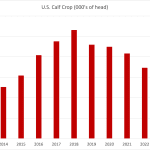Hog prices have recovered some ground from their early September slide,
but University of Missouri economist Ron Plain expects prices to fall
back in November.
“I think they’ll be lower than they are today,” said Plain.
According to Manitoba Agriculture, U.S. hog prices have increased by
seven to eight percent from the week of Sept. 9-13 to the week of Sept.
16-20. Plain said the top prices being paid have edged over $30 US per
100 pounds liveweight.
Read Also

Canola used in only quarter of Canadian biofuel
Less than one-quarter of the biodiesel and renewable diesel used in Canada in 2024 was made from canola oil feedstock
“I expect prices to dip back into the teens, close to, if not lower
than, the price at the start of September.”
But while that may seem like bad news, hog producers can take heart
from the fact that prices will not likely dive to anywhere near as low
as 1998, Plain said.
This time the slump began sooner, so it probably won’t be as bad.
“We started the price decline much earlier, which gives the
post-farmgate pork channel a lot more time to adjust,” said Plain.
In 1998, September prices were much higher than they are now. The
collapse came when a bigger than expected pig crop appeared in October.
Packers couldn’t kill or store all the slaughter weight pigs that were
offered to them.
Because there were more pigs than slaughter capacity, packers slashed
the prices they offered farmers for their animals. Because retailers
had not realized they were going to have a glut of pork, they had not
lowered prices to spur demand.
“This time there’s more opportunity to prepare for it,” said Plain.
Retail prices always lag changes in pig prices by about a month, Plain
said.
Since pig prices began slumping in late August, retailers have had time
to lower pork prices on the shelf to entice consumers to buy more of
it. When the big crunch comes in November, retailers should have
created a greater flow of pork to the consumer, allowing the packers to
move more meat.
Packers have also had time to hire workers so they can kill more pigs.
They will be able to increase production more quickly than in 1998,
when they were surprised by the sudden glut, Plain said.
November always tends to bring the lowest prices for hogs because hogs
tend to be heaviest that month, slaughter is slowed by American
Thanksgiving, and Americans eat more turkey and less pork during the
holidays, Plain said.
This year Canadian pigs aren’t putting additional strains on U.S.
slaughter plants, Plain said. Brandon’s Maple Leaf Foods plant is
killing more pigs and overall Canadian slaughter pig exports to the
United States have declined.

















